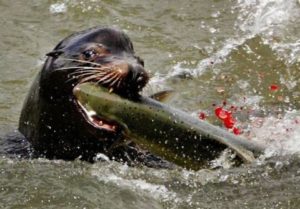Local News
Town hall on sea lion predation

Sea lion predation has been a growing problem for the past 10 or 15 years for the Treaty Tribes of the Columbia River.
Record numbers are now seen at Bonneville, Willamette Falls, at the mouth of the Columbia and elsewhere in the basin.
The Columbia River Inter-Tribal Fish Commission has been advocating for some solution to the problem, and Congress is considering a law to address the problem. The problem is evident in recent research:
A study by the National Oceanic and Atmospheric Administration found that a 45 percent of returning Columbia River spring chinook, including an Endangered Species Act-listed population, went missing in the lower Columbia. The estimate takes in to account harvests and other known impacts.
The reduced survival for spring chinook corresponds closely with the huge increase in California Sea lions entering the Columbia River.
Congress in June is scheduled to hold hearings on a law that would amend the Marine Mammal Protection Act to allow some control over the sea lion population in the Columbia. Tribal Councilman and CRITFC chair Carlos Smith will present the tribal case at the Congressional hearing on the bill, HB 564.
Before the June hearing, a town hall meeting is set for Saturday, May 30 at Oregon City, starting at noon. The town hall will be hosted by U.S. Congressman Kurt Schrader, along with the Columbia River tribes, Oregon Department of Fish and Wildlife, and the Coastal Conservation Association of Oregon.
Councilman Smith encourages all interested tribal members to attend the town hall (see page 10 for details).
Doug Hatch, senior fisheries scientist at CRITFC, has been studying the sea lion predation problem. “The California sea lion population has been growing exponentially,” Hatch said.
In the early 1970s the sea lion population was estimated at about 20,000 to 25,000. Since 1972, the year of the Marine Mammal Protection Act, the sea lion population has grown to about 325,000.
The sea lions are protected by the Marine Mammal Protection Act, not by the Endangered Species Act.
A similar situation happened this year with cormorants, protected by the Migratory Bird Act. A population explosion of cormorants on a man-made island in the Columbia resulted in the predation of millions of juvenile salmon.
An exception was made in the case of this specific cormorant population, allowing the U.S. Corps of Engineers to control the number of birds on the island.
In the case of the sea lions, the law would give the four Treaty Tribes of the Columbia, and CRITFC, the authority to apply for a permit to remove 10 to 12 sea lions.
When this permit is filled, the tribe could apply for another license until a total of 92 sea lions are taken per year.
Hatch says research indicates that, in at least some cases, the same sea lions are returning to the same areas of the Columbia. Removing these specific animals could alleviate the problem, he said.
The sea lion problem has become especially noticeable recently, Hatch said.
The situation appears related to a warming of waters off of California, which impacted the sardine population, a main food source for the sea lions in that area.
The sea lions migrated north, where some of them found the smelt run in the Columbia. They followed the run up the river, and have been seen in larger and larger numbers in places where they were not known to congregate.
The salmon are not the only fish species impacted by sea lion predation:
“Stellar sea lions are preying on broodstock-sized sturgeon, many of which are 50 to 70 years old and are vital for producing young. The Columbia River white sturgeon population has been in steep decline since the sea lion influx over the past 10 to 15 years. Currently there is no commercial or recreational harvest of these white sturgeon.”
